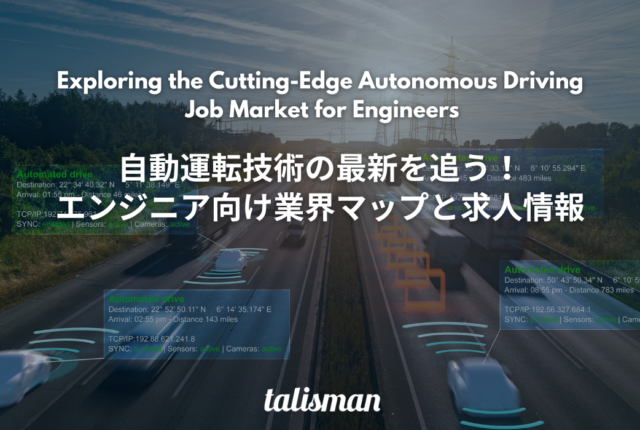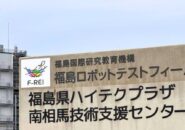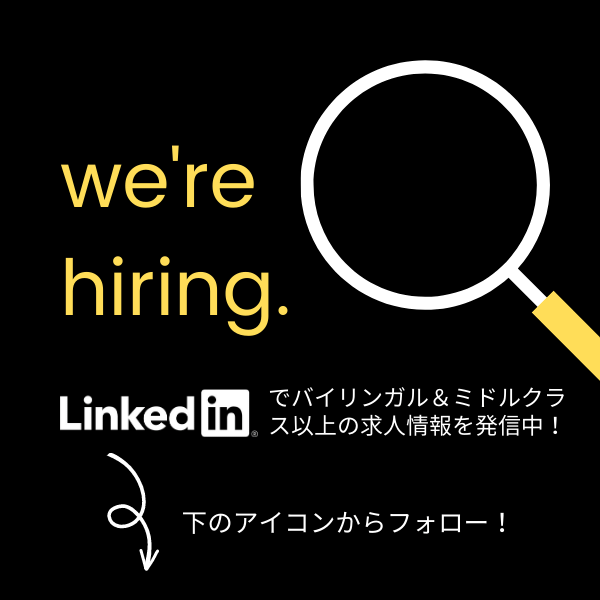自動車の自動運転技術は、交通事故の低減、渋滞の緩和、移動の効率化、環境問題の低減など、社会的課題の解決に大きな可能性を秘めていますが、同時に、この技術は自動車メーカーだけでなく、IT企業や通信企業、半導体、電池メーカーなど、多様な業種を巻き込んだ新たな産業エコシステムを形成しつつあります。
それに伴い、自動運転技術関連の専門知識や経験を持つ人材の需要が高まっており、ソフトウェア開発エンジニアをはじめ、AI開発エンジニア、センサー技術者、データアナリスト、さらにはプロジェクトマネージャーなど、幅広い職種で新たなキャリア機会も生まれています。
本記事では、自動車産業における最新の自動運転技術の動向と、それに伴う転職市場の変化について詳しく探っていきます。技術の最前線から、キャリアチェンジの可能性まで、自動運転がもたらす新たな機会の全容に迫ります。
-
こんにちは!このコンテンツのガイドをする、タリスマン株式会社 オートテック専門コンサルタントのK.Fです。
普段は自動運転・MaaS業界への転職のお手伝いをしていますので、このページを参考にしていただき、ご相談をいただけると嬉しいです。 AutoTechTeam
AutoTechTeam
K.F
目次
自動車業界は今、100年に一度の大変革期
電動化と自動運転技術の発展
2024年の世界の自動車販売台数は9,531万台(※1)、自動車産業全体の市場規模は約400兆円とされ、全産業中でも最大の市場規模となっています。自動車業界が巨大市場であることは言わずもがなですが、過去数十年で大きな技術的進化を遂げています。特に近年では「CASE(Connected コネクテッド、Automated/Autonomous 自動運転、Shared & Service シェアリング、Electrification 電動化)」という4つの概念が注目されています。これにより、業界全体が大きく変わりつつあり、自動車業界は今「100年に1度の大変革」と呼ばれる時期を迎えています。
EV(電気自動車)の販売台数は増加し続けており、IEA(国際エネルギー機関)の見通しでは2024年に販売されるEV等の電気自動車は約1700万台で、世界の新車販売台数の実に20%を占めるようになるとされています(※2)。この動きはカーボンニュートラル(二酸化炭素をはじめとする温室効果ガスの排出量と吸収量を均衡させること)の実現のためにも欠かせません。また、自動運転技術も、自動車業界の未来を形作る最重要技術の一つとされており、事故防止、交通効率化、人手不足解消という観点からも多くの期待が寄せられています。自動車メーカー各社は、新しいモビリティサービスの提供や、持続可能な交通システムの構築を目指しており、業界全体が進化を続けています。
(出典)
※1 OICA(国際自動車工業連合会)「Global Sales Statistics 2019 – 2023」
※2 IEA(国際エネルギー機関)Global EV Outlook 2024
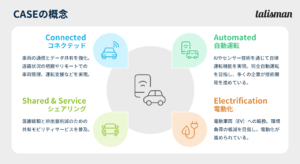
自動運転レベルと主要技術
自動運転技術は、レベル0(手動運転)からレベル5(完全自動運転)までの6段階に分類されており、日本では現在レベル2~3の技術が商業化されています。これらは部分的に自動化された運転をサポートする技術で、特定の条件下でドライバーの操作が不要になる場面も増えています。例えばレベル3では、高速道路での一定の自動運転が可能となり、ドライバーは特定の状況下でハンドルから手を離すこと(ハンズオフ)が許されています。
| 自動運転レベル – 名称 | 運転主体 | 運転レベルの概要 |
|---|---|---|
| 0 – 運転自動化なし | 運転者 | ドライバーが全ての運転タスクを担う。ADAS(先進運転支援システム)を搭載していない旧来の自動車 |
| 1 – 運転支援 | 運転者 | システムが前後・左右いずれかの車両制御を実施(アクセル・ブレーキ操作またはハンドル操作のどちらかが、部分的に自動化) 例:自動ブレーキ、前の車に付いて走る(ACC:Adaptive Cruise Control)、車線からはみ出さない(LKAS:Lane Keep Assist System) |
| 2 – 部分運転自動化 | 運転者 | システムが動的運転タスクの縦方向及び横方向両方(アクセル・ブレーキとハンドル操作の両方)の車両運動制御のサブタスクを限定領域において実行。 |
| 3 – 条件付運転自動化 | システム | 一定の条件下でシステムが全ての運転タスクを実行。自動運転時の主体はシステムに移るが、システムからの介入要求に対し運転者は適切に対応しなければならない。 |
| 4 – 高度運転自動化 | システム | システムが全ての運転タスクを実行する。作動継続が困難な場合への応答を限定領域において実行 |
| 5 – 完全自動運転 | システム | 常にシステムが全ての運転タスクを実行し運転操作の全部を代替する状態。 |
自動運転で必要なことは、人が運転する時と同じように「認知」・「判断」・「操作」の3つの動作を正確に繰り返すことです。以下は自動運転を支える重要な技術の一例です。
| 認知 | LiDAR (ライダー) |
車両が周囲の物体や地形を高精度に検知するために使われる技術です。レーザー光が物体に当たって跳ね返ってくるまでの時間を計測し、物体までの距離や方向を測定し、他の車両や障害物を識別するために活用されます。 |
|---|---|---|
| 認知 | HDマップ | 高精度3次元地図データは、自動運転車両がcm単位で正確な位置を把握し、交通規則や地形に基づいた判断を行うために不可欠です。 |
| 判断 | AI(人工知能) | 自動運転車両が環境を認識し、意思決定を行うために、AI技術は重要な役割を果たします。深層学習やデータ解析を駆使して、車両が周囲の状況を理解し、最適な運転判断を行います。 |
| 操作 | ソフトウェア開発 | ソフトウェアは、車両の安全運転を可能にするコア部分です。各センサーから得られるデータを処理し、車両の動きを制御するプログラムです。 |
自動運転に関する各国の動向(技術トレンドと規制) *2025/9/24更新
自動運転技術の発展に伴い、各国や企業は技術開発を競い合っており、並行して規制整備も進んでいます。また電動化と自動運転技術が相互に進化することで、クリーンな輸送手段の提供や交通インフラの効率化も進んでいます。市場では、交通事故の減少、物流の効率化、都市交通システムの再構築など、さまざまな分野で自動運転技術がもたらす変革が期待されています。
- アメリカ
WaymoやCruiseが、レベル3~4の技術の市場投入や試験走行を実施中です。特にアルファベット傘下のWaymoはカルフォルニア州サンフランシスコ、アリゾナ州フェニックスに続き2024年11月からロサンゼルスの一部でもレベル4自動運転タクシーの一般サービスの提供を開始し、順次エリアを拡大予定。Teslaは2024年10月、レベル4自動運転によるEVタクシーの試作車を発表しました。価格は3万ドル以下、日本円にして450万円以下で購入できるようにするとして、2026年の生産開始を目指しています。また、同社はロボタクシーサービスを2025年6月にテキサス州オースティンで開始する予定で、その後他の都市でも年内に運行を始める計画です。 - 中国
他国より自動運転サービスが浸透しつつある中国では、WeRide(文遠知行)やIT大手の百度(バイドゥ)が、レベル4自動運転のロボタクシーサービスを展開。中国国外でも走行許可を取得しており、米国やUAE、シンガポール、フランスなどでもサービスを展開予定です。また2025年4月に北京市で施行された条例では、L3以上の自家用車でも公道を走行できるようになり、技術革新や製品開発が加速すると見られています。 - 日本
トヨタやホンダが自動運転技術の開発に積極的です。トヨタは、MaaS(Mobility as a Service)の実現に向け、都市部での自動運転技術の商業運行を目指しています。また、ホンダは世界で初めてレベル3自動運転技術を搭載した市販車「レジェンド」をリリースし、日本国内での技術的なリーダーシップを確立しています。自動運転タクシーに関しては、前述のWaymoが、日本交通およびGOと提携し、国際ロードトリップとして2025年4月から東京で自動運転車の試験を開始すると発表しました。
その他、一部自治体にてレベル2~4でのバス運行が始まっており、現在多くのバス会社が抱えている運転手不足の問題を解決できるかが期待されています。
また2025年9月25日には、トヨタが静岡県裾野市に建設中のWoven City(ウーブンシティ: 自動運転、AI、ロボット、再生可能エネルギーを実装した「生きた実験都市」)が開業を迎え、実証実験を開始予定です。フェーズ1では約360人が居住する計画となっており、動向に注目が集まっています。
自動運転技術の進展と安全性への警告
2025年3月29日、中国安徽省で発生したXiaomi製電気自動車「SU7」の事故で大学生3名が命を落とし、自動運転支援技術の安全性に対する議論が再燃しています。車両は高速道路でのスマートアシスト運転の作動中に障害物を検知し、警告を出したものの、衝突を回避するには至らず事故が発生しました。それ以前にはアメリカでも複数回の死亡事故が発生しています。
自動運転技術は便利さや効率性を提供する一方で、安全性と倫理的課題も浮き彫りになっています。これらの事故は、自動運転技術がまだ発展途上であることを示しており、企業や規制当局、そしてユーザー全員が協力して安全性向上に取り組む必要があります。「技術は人間を完全に置き換えるものではなく、人間を補完するもの」という認識を持ちつつ、安全第一で活用していくことが求められます。
日本のモビリティDX戦略
上記のように各国で技術開発競争が進む中、日本においては経済産業省主導のもと、官民の議論を経て「モビリティDX戦略」が2024年5月に策定されました。戦略の最終目標は2035年SDV(※)のグローバル販売台数の日系シェア率3割の実現としています。その後2025年6月には、AI活用型自動運転の実装競争激化や地政学リスクの高まりといった直近の環境変化を踏まえ改定されています。
※SDV(Software Defined Vehicle):車と外部との間の双方向通信機能を使って車を制御するソフトウェアを更新し、販売後も機能を増やしたり性能を高めたりできる自動車
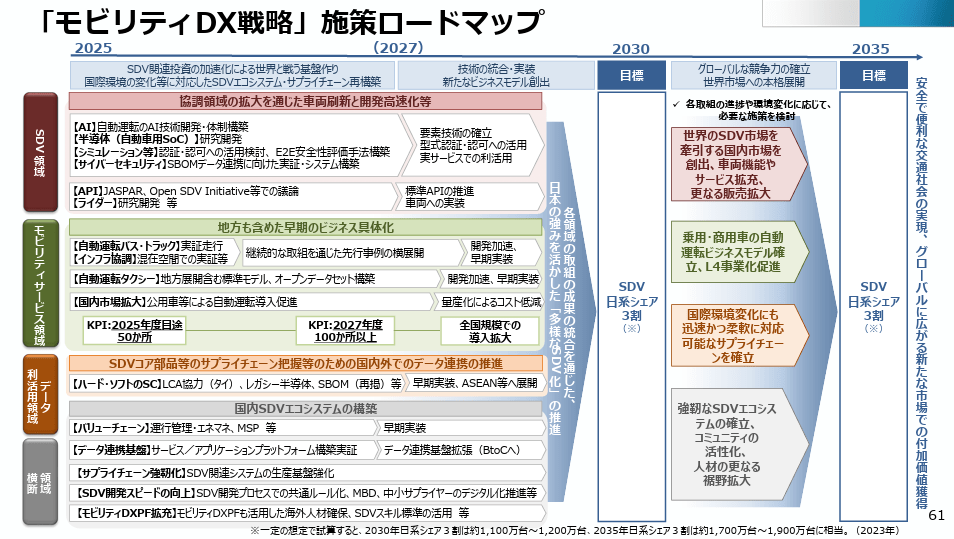
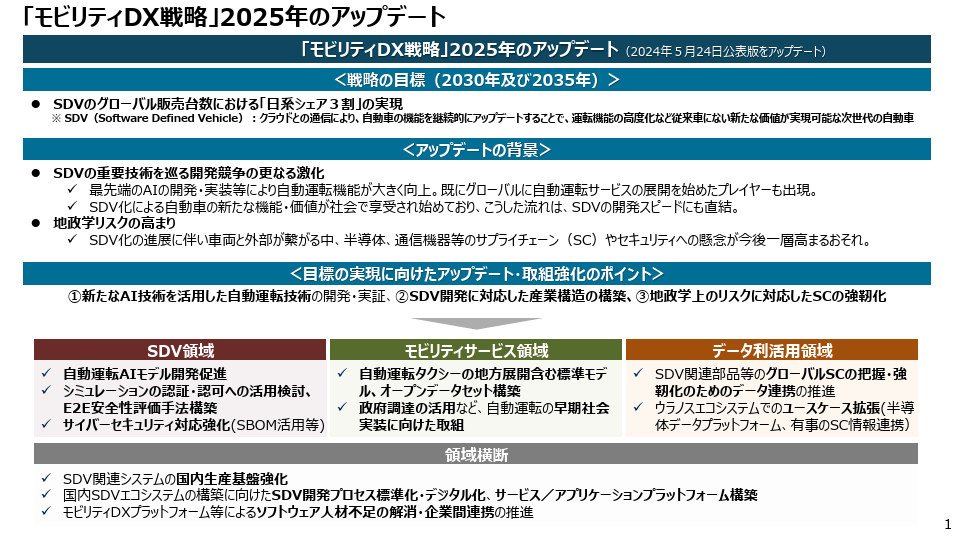
戦略のロードマップでは、モビリティサービス領域におけるKPIとして、政府は2025年度をめどに全国50か所程度、2027年度までに100か所以上で、レベル4の自動運転システムを活用した移動サービスの実現を掲げています。さらにソフトウェアエンジニア人材の確保に向けても施策が盛り込まれ、「モビリティDXプラットフォーム」といったコミュニティの立ち上げを計画するなど、人材面の課題も強く認識されたものになっています。
自動運転・MaaS業界マップの紹介
画像は35ish編集部が作成した自動運転・MaaSの注目企業をセグメント別にまとめた業界マップです。
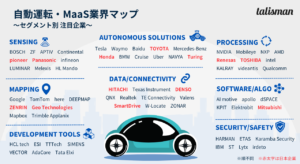
日本企業(赤色太字で表示)として、大手自動車メーカーや半導体メーカーが目に入るのはもちろんですが、以下に特に注目のスタートアップ企業を紹介します。
- Turing チューリング株式会社
2021年8月設立ながら、当初から「自動車メーカー」を掲げるチューリング。CEOの山本氏は「Teslaを超える完成車メーカーを作る」と明言し、ミッションを「We Overtake Tesla」に定めています。2030年までに自社で1万台の完全自動運転EV量産を目標に掲げている点も目を引きます。 - SmartDrive 株式会社スマートドライブ
スマートドライブ(2013年〜)は、「移動の進化を後押しする」を創業期からビジョンとして掲げ、移動体にまつわるさまざまなセンサーデータを収集・解析しオープンなプラットフォームで展開しています。大企業での導入実績・提携事例も多く、2022年12月には東証グロース市場への上場も果たしました。
また、以下は自動運転技術関連の注目企業の一覧です。カテゴリごとに検索もできますので情報収集等にお役立てください。
※タリスマンDeepTech専門チームの自動運転関連クライアントリスト(候補を含む)を元に35ish編集部が作成
| 分類 | 企業名 / Website | 国 |
|---|---|---|
| AUTONOMOUS SOLUTIONS | Audi | |
| AUTONOMOUS SOLUTIONS | Ford | |
| AUTONOMOUS SOLUTIONS | Hyundai | |
| AUTONOMOUS SOLUTIONS | KIA motors | |
| AUTONOMOUS SOLUTIONS | Stellantis | |
| AUTONOMOUS SOLUTIONS | Volkswagen | |
| AUTONOMOUS SOLUTIONS | Toyota | |
| AUTONOMOUS SOLUTIONS | Nissan | |
| AUTONOMOUS SOLUTIONS | BAIC | |
| AUTONOMOUS SOLUTIONS | Mercedes-Benz | |
| AUTONOMOUS SOLUTIONS | BMW | |
| AUTONOMOUS SOLUTIONS | GM | |
| AUTONOMOUS SOLUTIONS | Honda | |
| AUTONOMOUS SOLUTIONS | Jaguar | |
| AUTONOMOUS SOLUTIONS | GEELY | |
| AUTONOMOUS SOLUTIONS | Renault | |
| AUTONOMOUS SOLUTIONS | Tesla | |
| AUTONOMOUS SOLUTIONS | Volvo | |
| AUTONOMOUS SOLUTIONS | SAIC | |
| AUTONOMOUS SOLUTIONS | CHANGAN | |
| AUTONOMOUS SOLUTIONS | CHERY | |
| AUTONOMOUS SOLUTIONS | Waymo | |
| AUTONOMOUS SOLUTIONS | LYFT | |
| AUTONOMOUS SOLUTIONS | NAVYA | |
| AUTONOMOUS SOLUTIONS | Torc Robotics | |
| AUTONOMOUS SOLUTIONS | SD advanced engineering | |
| AUTONOMOUS SOLUTIONS | Uber | |
| AUTONOMOUS SOLUTIONS | Easy mile | |
| AUTONOMOUS SOLUTIONS | 2get there | |
| AUTONOMOUS SOLUTIONS | Baidu 百度 | |
| AUTONOMOUS SOLUTIONS | Zoox | |
| AUTONOMOUS SOLUTIONS | Nauto | |
| AUTONOMOUS SOLUTIONS | May mobility | |
| AUTONOMOUS SOLUTIONS | NXP | |
| AUTONOMOUS SOLUTIONS | ZF | |
| AUTONOMOUS SOLUTIONS | NVIDIA | |
| AUTONOMOUS SOLUTIONS | MAGNA | |
| AUTONOMOUS SOLUTIONS | Continental | |
| AUTONOMOUS SOLUTIONS | BOSCH | |
| AUTONOMOUS SOLUTIONS | Aptiv | |
| AUTONOMOUS SOLUTIONS | HITACHI | |
| AUTONOMOUS SOLUTIONS | Renesas | |
| AUTONOMOUS SOLUTIONS | SAMSUNG | |
| AUTONOMOUS SOLUTIONS | intel | |
| AUTONOMOUS SOLUTIONS | Visteon | |
| AUTONOMOUS SOLUTIONS | ZMP | |
| AUTONOMOUS SOLUTIONS | RoboCV | |
| AUTONOMOUS SOLUTIONS | Turing | |
| PROCESSING | Renesas | |
| PROCESSING | NVIDIA | |
| PROCESSING | Mobileye | |
| PROCESSING | KALRAY | |
| PROCESSING | Synopsys | |
| PROCESSING | NXP | |
| PROCESSING | TOSHIBA | |
| PROCESSING | CEVA | |
| PROCESSING | cadence | |
| PROCESSING | Imagination Technologies | |
| PROCESSING | Analog Devices | |
| PROCESSING | AMD | |
| PROCESSING | intel | |
| PROCESSING | arm | |
| PROCESSING | Outsight | |
| PROCESSING | ST | |
| PROCESSING | videantis | |
| PROCESSING | Texas Instrument | |
| PROCESSING | MARVELL | |
| PROCESSING | Graphcore | |
| PROCESSING | Qualcomm | |
| PROCESSING | AI motive | |
| SENSING | BOSCH | |
| SENSING | Texas Instrument | |
| SENSING | ZF | |
| SENSING | Mitsubishi | |
| SENSING | Continental | |
| SENSING | microvision | |
| SENSING | Valeo | |
| SENSING | XenomatiX | |
| SENSING | arbe | |
| SENSING | TOSHIBA | |
| SENSING | HITACHI | |
| SENSING | Luminar | |
| SENSING | Autoliv | |
| SENSING | KOSTAL | |
| SENSING | HYUNDAI MOBIS | |
| SENSING | Aptiv | |
| SENSING | INNOVIZ | |
| SENSING | Pioneer | |
| SENSING | DENSO | |
| SENSING | robosense | |
| SENSING | LG Innotek | |
| SENSING | LYNRED | |
| SENSING | Panasonic | |
| SENSING | HARMAN | |
| SENSING | Denso ten | |
| SENSING | MAGNA | |
| SENSING | OUSTER | |
| SENSING | TetraVue | |
| SENSING | QUANERGY | |
| SENSING | Aeye | |
| SENSING | Teledyne FLIR | |
| SENSING | FORVIA HELLA | |
| SENSING | novatel | |
| SENSING | Infineon Technologies | |
| SENSING | ECHODYNE | |
| SENSING | HL Mando | |
| SENSING | Leddar Tech | |
| SENSING | Trimble Applanix | |
| SENSING | NXP | |
| SENSING | Trimble | |
| SENSING | U-blox | |
| SENSING | Honeywell | |
| SENSING | SBG SYSTEMS | |
| SENSING | OMNIVISION | |
| SENSING | OSRAM | |
| SENSING | SIMENS | |
| SENSING | Melexis | |
| SENSING | Lumentum | |
| SENSING | SONY | |
| DATA/CONNECTIVITY | HITACHI | |
| DATA/CONNECTIVITY | Renesas | |
| DATA/CONNECTIVITY | NXP | |
| DATA/CONNECTIVITY | Continental | |
| DATA/CONNECTIVITY | Texas Instrument | |
| DATA/CONNECTIVITY | BlackBerry QNX | |
| DATA/CONNECTIVITY | BOSCH | |
| DATA/CONNECTIVITY | MARVELL | |
| DATA/CONNECTIVITY | Analog Devices | |
| DATA/CONNECTIVITY | Semtech | |
| DATA/CONNECTIVITY | intel | |
| DATA/CONNECTIVITY | Realtek | |
| DATA/CONNECTIVITY | Cohda Wireless | |
| DATA/CONNECTIVITY | BROADCOM | |
| DATA/CONNECTIVITY | TTTech | |
| DATA/CONNECTIVITY | TE Connectivity | |
| DATA/CONNECTIVITY | Valens | |
| DATA/CONNECTIVITY | Elektrobit | |
| DATA/CONNECTIVITY | microchip | |
| DATA/CONNECTIVITY | DENSO | |
| DATA/CONNECTIVITY | HARMAN | |
| DATA/CONNECTIVITY | Infineon Technologies | |
| DATA/CONNECTIVITY | SIMENS EDA | |
| DATA/CONNECTIVITY | molex | |
| DATA/CONNECTIVITY | SmartDrive | |
| DATA/CONNECTIVITY | GreenRoad | |
| DATA/CONNECTIVITY | W-Locate | |
| DATA/CONNECTIVITY | Vnomics | |
| DATA/CONNECTIVITY | ZONAR | |
| DATA/CONNECTIVITY | Peloton Technology | |
| DATA/CONNECTIVITY | Car IQ | |
| DATA/CONNECTIVITY | IMS | |
| DATA/CONNECTIVITY | metromile | |
| DATA/CONNECTIVITY | Zubie | |
| DATA/CONNECTIVITY | Vinli | |
| DATA/CONNECTIVITY | MOJIO | |
| DATA/CONNECTIVITY | Airbiquity | |
| DATA/CONNECTIVITY | Automile | |
| MAPPING | TomTom | |
| MAPPING | here | |
| MAPPING | ||
| MAPPING | NavInfo | |
| MAPPING | Sanborn | |
| MAPPING | Dynamic Map Platform | |
| MAPPING | DEEPMAP | |
| MAPPING | GeoDigital | |
| MAPPING | Geo Technologies | |
| MAPPING | Civil Maps | |
| SOFTWARE/ALGO | Baidu 百度 | |
| SOFTWARE/ALGO | Mapbox | |
| SOFTWARE/ALGO | ZENRIN | |
| SOFTWARE/ALGO | Trimble Applanix | |
| SOFTWARE/ALGO | apollo | |
| SOFTWARE/ALGO | Elektrobit | |
| SOFTWARE/ALGO | dSPACE | |
| SOFTWARE/ALGO | NVIDIA | |
| SOFTWARE/ALGO | AI motive | |
| SOFTWARE/ALGO | Five AI | |
| SOFTWARE/ALGO | Mitsubishi | |
| SOFTWARE/ALGO | oxa | |
| SOFTWARE/ALGO | Outsight | |
| SOFTWARE/ALGO | KPIT | |
| SOFTWARE/ALGO | BASELABS | |
| SOFTWARE/ALGO | Luxoft | |
| SOFTWARE/ALGO | Neusoft | |
| SOFTWARE/ALGO | Nauto | |
| SOFTWARE/ALGO | Mobileye | |
| SOFTWARE/ALGO | HCL tech | |
| SOFTWARE/ALGO | AURORA | |
| SECURITY/SAFETY | HARMAN | |
| SECURITY/SAFETY | Karamba Security | |
| SECURITY/SAFETY | BOSCH | |
| SECURITY/SAFETY | SIMENS EDA | |
| SECURITY/SAFETY | Aptiv | |
| SECURITY/SAFETY | Continental | |
| SECURITY/SAFETY | Wind River | |
| SECURITY/SAFETY | HITACHI | |
| SECURITY/SAFETY | NXP | |
| SECURITY/SAFETY | IBM | |
| SECURITY/SAFETY | verizon | |
| SECURITY/SAFETY | Renesas | |
| SECURITY/SAFETY | PlaxidityX | |
| SECURITY/SAFETY | BlackBerry QNX | |
| SECURITY/SAFETY | intel | |
| SECURITY/SAFETY | DENSO | |
| SECURITY/SAFETY | ETAS | |
| SECURITY/SAFETY | Green Hills Software | |
| SECURITY/SAFETY | LYNX | |
| SECURITY/SAFETY | secunet | |
| SECURITY/SAFETY | irdeto | |
| SECURITY/SAFETY | Synopsys | |
| SECURITY/SAFETY | ST | |
| SECURITY/SAFETY | KPIT | |
| SECURITY/SAFETY | Rambus | |
| SECURITY/SAFETY | Texas Instrument | |
| SECURITY/SAFETY | Infineon Technologies | |
| SECURITY/SAFETY | VECTOR | |
| SECURITY/SAFETY | CAMBRIDGE MOBILE TELEMATICS | |
| SECURITY/SAFETY | Lytx | |
| DEVELOPMENT TOOLS | HCL tech | |
| DEVELOPMENT TOOLS | Ansys | |
| DEVELOPMENT TOOLS | Polysync | |
| DEVELOPMENT TOOLS | ESI | |
| DEVELOPMENT TOOLS | IAR | |
| DEVELOPMENT TOOLS | Dataspeed Inc. | |
| DEVELOPMENT TOOLS | INTEMPORA | |
| DEVELOPMENT TOOLS | LDRA | |
| DEVELOPMENT TOOLS | Mechanical Simulation | |
| DEVELOPMENT TOOLS | MathWorks | |
| DEVELOPMENT TOOLS | Synopsys | |
| DEVELOPMENT TOOLS | TTTech | |
| DEVELOPMENT TOOLS | dSPACE | |
| DEVELOPMENT TOOLS | IAV | |
| DEVELOPMENT TOOLS | ETAS | |
| DEVELOPMENT TOOLS | Elektrobit | |
| DEVELOPMENT TOOLS | AdaCore | |
| DEVELOPMENT TOOLS | KPIT | |
| DEVELOPMENT TOOLS | SIMENS | |
| DEVELOPMENT TOOLS | VECTOR | |
| DEVELOPMENT TOOLS | b-plus | |
| DEVELOPMENT TOOLS | BASELABS | |
| DEVELOPMENT TOOLS | IPG | |
| DEVELOPMENT TOOLS | SIMENS EDA | |
| DEVELOPMENT TOOLS | AMD | |
| DEVELOPMENT TOOLS | Maplesoft | |
| DEVELOPMENT TOOLS | AutonomouStuff | |
| DEVELOPMENT TOOLS | Tata Elxsi |
自動車産業における求人市場の現状
経済産業省の資料でも、SDV化を阻む最大の要因は「ソフトウェア人材の圧倒的な不足」であると記載されている通り、大変革期にある自動車業界では、IT系専門職の需要が急増しています。このセクションでは、自動車業界の求人状況について、現状と求められる人物像について解説していきます。
全体的な求人動向
自動車業界では、ソフトウェア関連の求人が急増しています。背景には、SDV(Software Defined Vehicle)の進展により、ソフトウェアが車両の機能や性能に大きな影響を及ぼすようになっていることがあります。特に、5G技術の普及により、自動運転システムや車両のネットワーク接続、OTA(Over The Air:無線通信を使ったソフトウェアの更新や情報収集)を含むコネクテッド分野での採用ニーズが高まっています。この流れは、車載システムやサイバーセキュリティ関連の領域にも波及し、求人数はここ数年で著しく増えている状況です。
求人が増加している分野
ソフトウェア関連で求人が増加している分野としては、自動運転技術、コネクテッドシステム、サイバーセキュリティ、MaaS(Mobility as a Service)が挙げられます。幅広い職種で採用が進んでおり、特にMaaS分野ではデータ分析やモバイルアプリの開発に関する求人が多く見られます。
SEやインフラエンジニアの採用では、システムの開発や運用スキルが重視されるため、これらは自動車業界未経験からでも挑戦しやすい職種と言えます。一方で、組み込みエンジニアについては自動車業界の経験が応募要件になることが多く、業界内での転職が一般的です。ADAS(Advanced Driver Assistance System:先進運転支援システム)やAD(Autonomous Driving)の開発においてはシミュレーションを用いたモデルベース開発(MBD)が主流となっており、従来の実車テストよりも多くのシチュエーションをテストできるなど様々なメリットをもたらしています。それゆえにモデルとミューレーションの開発スキルを持つエンジニアが必要とされています。
求められる人物像やスキル
-
学歴より職歴重視の傾向
自動車業界全体として学歴より職歴が重視される傾向があります。実際の求人票においても「大卒・理系(技術系)」程度の記載にとどまることが多いです。転職においては業界を問わず前職での経験やスキルを中心に応募書類の作成や面接の対策をしましょう。 -
クセつよな人が多い?
自動車は「ものづくり」であるため、特に組み込みエンジニアなどでは技術に強い情熱を持つ人、職人気質な人が多いです。創造性や探究心があるかどうかは重要な要素ですし、新しい技術を積極的に学び、技術的な探究心を持ち続ける姿勢が評価されます。 - 自動運転技術分野では
自動運転技術分野では、以下のような専門知識やスキルを持つ人が特に歓迎されます。- DAS(Driver Assistance Systems)カメラ: 自動車の周囲の状況を検出するためのカメラ技術です。これらのカメラは車線の維持、衝突回避、交通標識の認識などをサポートするシステムに使用されます。DASカメラの設計やデータ処理に詳しい人は重宝されます。
- AUTOSAR(AUTomotive Open System ARchitecture): 自動車業界で広く使用されているソフトウェアアーキテクチャの標準規格です。AUTOSARを用いて、車載ソフトウェアの互換性と効率性を高めることができるため、この知識を持つ人は自動運転車の開発において重要です。
- MATLAB/Simulink/Stateflow: モデリング、シミュレーション、アルゴリズムの開発に使われるツールです。自動運転技術では、車両の制御システムや動作のシミュレーションを行うために使われるため、これらのツールを熟知している人が求められます。
- ECU(Electronic Control Unit): 車両内でのさまざまな制御機能を担う電子制御ユニットです。自動運転システムでは、ブレーキ、ステアリング、エンジンなどを含む車両全体の自動制御が求められ、ECUに関する理解がある人は開発の現場で歓迎されます。
これらの技術に精通している人は、自動運転車の精度向上や安全性確保に貢献できるため、高く評価されるでしょう。
自動運転・MaaS業界への転職活動のヒント
1. 求人の探し方
① 主要な求人サイトの活用
- LinkedIn↗︎
「LinkedIn」はグローバルなネットワークを通じて、自動車関連の企業や採用担当者と直接つながることができる強力なツールです。プロフィールを最新の情報に更新し、関連スキルや経験を強調しておくことで、エージェントやリクルーターからのスカウトが期待できます。 - doda↗︎
「doda(デューダ)」は、総合求人・転職サイトで、日本ではよく利用されています。自動車関連では採用のニーズに対して登録している候補者の母数が少ないためか、1ヶ月で100通以上のスカウトがあることもあります。
② エージェントやスカウトサービスを活用
- 転職エージェントを利用するメリット
- 自動車業界に精通した転職エージェントは、非公開求人を紹介してくれる可能性が高く、エージェント経由でのスカウトも多く存在します。また、応募書類のブラッシュアップや面接対策のサポートも受けられるため、初めての転職でも安心して進めることができます。

K.F
- スカウトされるには
- どの媒体においても言えることですが、質の良いスカウトを受け取るためにはちょっとしたコツが必要です。いくらあなたがすごいスキルや経験を持っていたとしても、職種だけが書かれているような簡素なプロフィールからはそれを読み取ってもらうことができません。技術的なスキルや開発プロジェクトでの経験を詳細に記載し、プロフィールを魅力的に見せられると、企業のリクルーターの目に留まりやすくなります。
2. 自動車業界特有の面接対策
① 面接での重要ポイント
1. 実績を具体的に示す
自動車業界の面接では、特に技術職の場合、具体的な経験や実績を示すことが重要です。面接官は応募者のテクニカルスキルを評価するために、過去のプロジェクトや業務の詳細を求めます。具体的な成果、プロジェクトでの役割、使用した技術やツール、直面した課題への対処法などを数字や具体的な事例で説明すると効果的です。
2. 業界知識とトレンドへの理解
自動車業界はCASEなどの技術革新が急速に進んでいるため、最新の業界トレンドや技術的な進展に精通していることを示す必要があります。面接では、「現在の業界トレンドにどう対応しているか」「自動運転技術や電動化の進展が今後の業界にどのような影響を与えるか」など、見解を求められることもあります。自分の知識を示し、業界の未来を見据えてどのように貢献できるかをアピールすることで、印象が高まります。
② よく聞かれる質問例
自動車業界の面接では、業界特有の専門性や実務経験を問う質問が多く見られます。以下はよく聞かれる質問の例です。
「これまでに関わった車両の設計や開発プロジェクトを教えてください。その中で直面した課題と、その課題に対してどのように対処しましたか?」
「自動車の機械設計や電子制御システムにおいて、どのような技術やツールを使用して作業しましたか?」
「電動化や自動運転技術の開発経験について詳しく説明してください。」
「これまでの自動車業界での経験の中で、最も大きな成果を挙げたプロジェクトは何ですか?」
「自動車業界のトレンドや最近の技術的な進展について、どのようにキャッチアップしていますか?」
「過去の職場で、部門をまたぐコラボレーションを行ったことがありますか?その経験がプロジェクトにどのように役立ちましたか?」
タリスマンからのサポート紹介
自動車業界における転職を成功させるためには、専門的なサポートを受けることをおすすめします。タリスマンでは、求職者のニーズに合わせた包括的なサポートを提供しています。以下は、当社の主なサポート内容です。
1. 履歴書レビューと応募書類のブラッシュアップ
- 求職者の志望度や希望条件の確認
- まず、求職者が抱える具体的なキャリア目標や勤務地、ポジションに対する希望を詳細にヒアリングします。希望する技術分野やキャリアパスの確認を行うことで、候補者にとって最適な企業やポジションを特定します。この過程を経ることで、直接応募では得られない高いマッチング精度を実現します。
- 履歴書のブラッシュアップ
- 作成いただいた応募書類についても企業提出前に確認をし、必要に応じてアドバイスが可能です。また、2言語のレジュメが必要な場合もあります。タリスマンには複数のバイリンガルコンサルタントや外国籍コンサルタンが在籍しているため、日本語・英語・中国語のレジュメに対応が可能です。
2. 面接対策とフォローアップサポート
- 不安解消と面接対策
- 面接に臨む前に、求職者が抱える不安や疑問をしっかりと共有し、面接で自信を持って臨めるようサポートします。具体的な質問への対応方法や、自動車業界特有の技術的な質問に備えるためのアドバイスも行います。また、面接後のフィードバックを迅速に提供し、次のステップに進むための追加情報や改善点を確認します。
- 日本と外国の面接の違いへの対応
- 特に海外からの求職者に対しては、日本の面接スタイルや企業文化の違いを丁寧に説明します。ポジションごとの面接の流れや、企業側の希望に応じた面接スケジュールの調整もサポートします。企業との連絡窓口として、オファーが出るまでの調整をスムーズに進め、求職者が不安なくプロセスを進められるようにします。
3. 複数の選考プロセスに対する調整
- スケジュール調整と情報共有
- 求職者が複数の企業の面接を受ける際には、それぞれのスケジュールや選考進行状況を共有し、最適なタイミングで面接を進められるように調整します。焦ることがなく効率的に複数の選考をこなし、最良のタイミングで決断できるようなサポートは、エージェントを利用する大きなメリットのひとつです。
 この記事の監修者:DeepTech専門チーム
この記事の監修者:DeepTech専門チーム
K.Fのコメント自動運転・MaaS業界は、既存の自動車産業の枠を超え、ソフトウェアエンジニアリングとの融合を果たしました。今、この新しいエコシステムは、幅広い専門知識をもった人材を求めています。外資・日系のグローバル企業からスタートアップまで様々な企業とつながる私たちが、精一杯転職のサポートをさせていだたきます。
PickUp求人情報
下記求人情報の詳細はDeepTech専門チームまでお問い合わせください
- 【アプリケーションエンジニア】
- 外資系EVアプリ開発企業
- 電子制御ユニット(ECU)のテストのためのシミュレーションの分野を担当頂きます。MATLAB/Simulinkを用いたシミュレーション実務経験必須。
- 年収:600~700万円/勤務地:東京
- 【Embedded Engineer】
- 外資系EVアプリ開発企業
- 電子制御ユニット(ECU)をはじめとした組込ソフトウエア開発に必要なシステムのカスタマイズ/技術サポート/導入支援/コンサルティングなどを行っていただきます。組込ソフトウェア開発経験 (マイコンを対象としたC言語開発等)、英語力必須
- 年収:500~1100万円/勤務地:東京
- 【ビジネスディベロップメントマネージャー】
- 大手外資系カーエレクトロニクス開発企業
- 車載組込ソフトウェアプロダクトの導入提案などのプリセールス活動をご担当頂きます。分野問わず、組込ソフトウェア開発経験3年以上、英語必須
- 年収:800~1200万円/勤務地:東京or大阪or名古屋
- 【アプリケーションエンジニア】
- 外資系ITメーカー
- ラピッドプロトタイピング製品のエンジニアリング・コンサルティングサービスの提供を担当頂きます。業界を問わず、リアルタイム処理が必要な機器の研究開発・設計のご経験およびC言語、Python、MATLAB/Simulinkいずれかのご経験必須。
- 年収:500万円~1100万円/勤務地:東京

